Uncommon First Aid Items We Should All Have
Today, we’ll discuss many uncommon First Aid items we should consider having around and adding to our stash so we’re prepared for first aid issues. Building a first aid kit is a great way to ensure that you’ll have easy access to essential tools during a medical emergency.
It’s always a good idea to have one of these kits at home and in your car, especially if you travel often because you never know what could happen while you’re on the road.
While most people know the essential items to include in these kits, such as aspirin, gauze/bandages, and antiseptic ointment, a few unusual items are worth adding to your first aid kit. If you’re unsure what those uncommon items are, check out this detailed list! In case you missed this post, here are the First Aid Kits.
In case you need a Printable First Aid Kit List
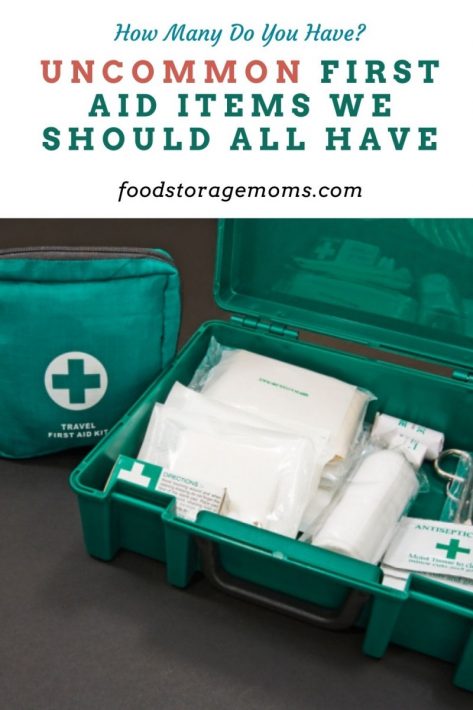
Uncommon First Aid Items
It’s good to have a variety of remedies available when you need healing medications in a hurry. Some may be considered as a home remedy that doesn’t require a prescription, but most are over-the-counter solutions you can buy in many local stores.
Super Glue or VetBond
If you have a small cut, it helps to have some superglue available. You’re probably wondering why you’d need superglue in your kit. When you have a minor cut that continues bleeding, you can clean it off by wiping away the blood and dirt using an antiseptic and then quickly applying super glue to the affected area.
It’s a great way to stop the bleeding so that your injury can start to heal. You won’t need too much superglue to make this happen.
Also, don’t use superglue if you have a significant wound because it won’t work. Be aware that applying it may cause the wound to sting briefly. Super Glue or VetBond If you have any allergic reactions, stop using this remedy immediately.
Note that I’ve heard the following items are also good to have around to stop the bleeding:
Blood Stop – Advanced Clotting Spray
Sam Soft Splint
Matt reminded me about having a few bendable soft splints available for broken arms, etc. Sam Soft Splints. This is a short-term solution until you can see your healthcare provider for professional treatment.
Arnicare Gel
I had a special friend, Lisa, send me pictures of her arm after a particular surgery; she said it was in excruciating pain, swollen, and bruised. Guess what? This stuff helped. Arnicare Gel. Thank you, Lisa, for sharing your pictures and experience with this product.
After Surgery
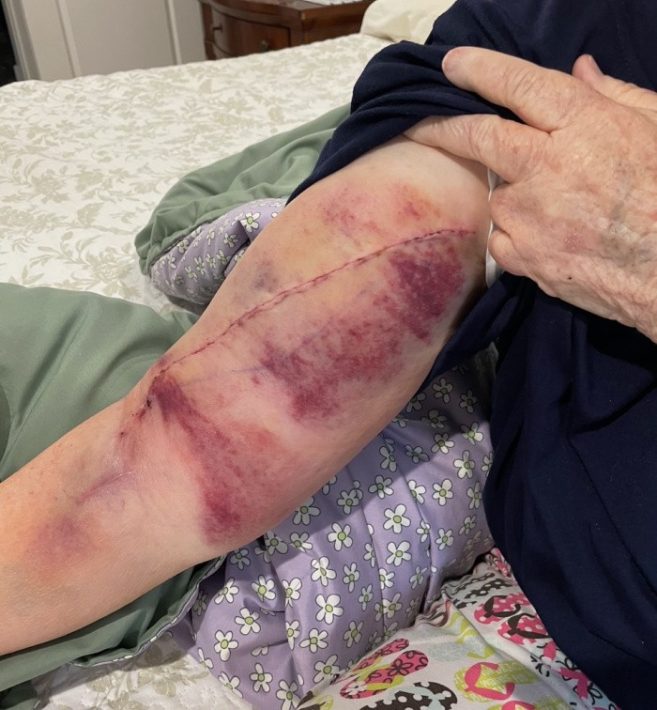
Two Weeks Later
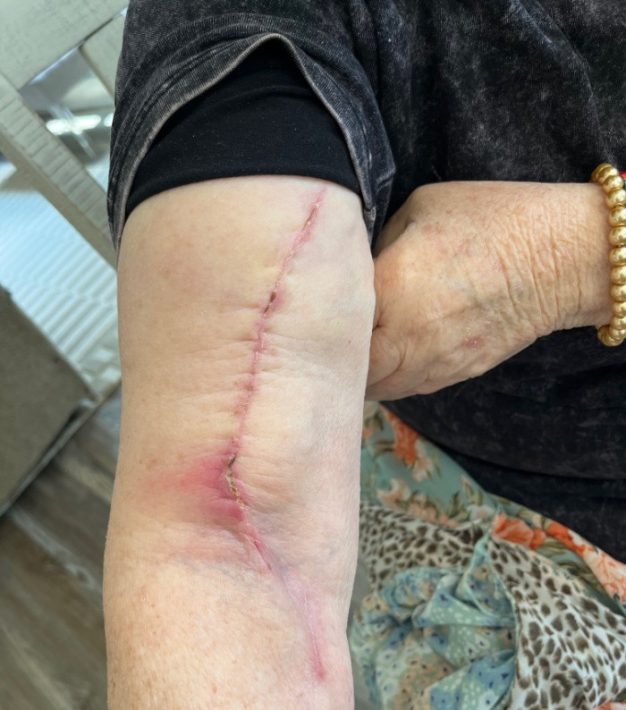
Zanfel
Thank you, Ray, for reminding me about this product for Poison Ivy. Zanfel
Hand Sanitizer
Well, it might not seem as uncommon in today’s world because of the widespread use of this item, but hand sanitizer is an excellent addition to your first-aid kit. While most people wouldn’t think to put it in the kit, it’s great to have access to it because it kills germs and bacteria on the spot.
Various types of hand sanitizer are available, so make sure you try different types if you are prone to allergies and have any reactions.
Scissors
Always have a good pair of scissors in your first aid kit. You may consider sharper scissors than the safety ones often found in kits. The safety scissors typically aren’t as sharp as needed when dealing with an emergency. Trauma/Medical Shears
There are a few good reasons to have scissors in your first aid kit. First, you may need to cut gauze and bandages to fit specific wounds.
Second, if you need to make a tourniquet for an emergency, you may need scissors to cut the fabric of a T-shirt or some other material. Get yourself a good pair of sharp scissors to put to good use!
To tie in with the scissors theme, I’d also suggest you consider buying a suture kit. Mark and I took a first aid class some years ago, and they taught us how to sew up a wound. I think the instructor brought some pigskin for us to practice with. It was weird, but it was useful information we may need to use someday.
Duct Tape
Many people don’t realize that duct tape can be helpful in emergencies. For example, if you don’t have bandages and need to protect an open wound, use duct tape to apply gauze and keep it in place: Duct Tape or Gorilla Duct Tape.
While you can use it on yourself if you sustain an injury, duct tape can also come in handy for fixing issues with your vehicle and belongings when you’re away from home.
It’s always good to have because of its durability and many uses. If you plan to add it to your first aid kit, ensure you’re getting a good brand that is as reliable as possible when needed.
Dental floss, razor blades, braided fish lines, and goggles are other valuable items in a pinch. Check them out and consider how they could make a difference during an emergency.
Solar Phone Charger
A solar phone charger is a must-have, especially if you like traveling in your vehicle to new places. If you don’t have an electrical source for charging your phone, it can die, and you can’t stay connected with your loved ones. Solar Phone Charger
Bring a solar phone charger with you in your first aid kit if you want to ensure that you can charge your phone if it dies. If possible, you might even want to get a battery-operated charger in case you need power during the night.
Of course, you can always bring spare batteries just in case the battery-operated charger dies when you need it the most.
Strong Antiseptic
It may not be one of the things you’d expect to see in a first aid kit, but it’s beneficial for several reasons. First, the antiseptic works as a disinfectant and an anesthetic, making it a great item to include in your first aid kit. You can use it to clean open wounds to avoid infection by killing germs.
It also works on poison ivy, bug bites, bee stings, and other skin irritations. Best of all, it doesn’t matter what kind you use. You don’t need to buy an expensive brand to add to your first aid kit. You can try regular fluids, gels, and creams until you find one that suits your needs.
Instead, grab an affordable bottle and place it in the kit with the rest of your equipment to use when needed. Isopropyl Alcohol and Hydrogen Peroxide
Safety Pins
Be sure to include a few safety pins in your first aid kit. These pins can help you keep bandages in place when wrapping an arm, leg, or other part of the body. They can also keep wraps and bandages secure and in place until you seek professional medical treatment at a hospital or urgent care facility.
Old T-Shirt
Remember to pack an old T-shirt in your first aid kit. You never know when you might need some material, whether to make a tourniquet or stop the bleeding of a wound by putting pressure on it. Use a thick and durable T-shirt that you no longer wear. Adding this garment to your first aid kit doesn’t hurt because unexpected emergencies can occur at inconvenient times.
Uncommon First Aid Items We Should All Have
Some other items I suggest could come in handy are listed below. Take a few minutes to check them out and see if you think they are worthy of inclusion in your first aid supply kit or cabinet:
Tampons – Sanitary Napkins
Chewable Ginger
Natural Antibiotics – like honey
Hard Candies
Final Word
Ensure you’re fully prepared for emergencies by packing unusual items into your first aid kit with the rest of your supplies. While things like a potent antiseptic, an old t-shirt, safety pins, and scissors might not sound like the essential items you could put to good use in an emergency, they’re more convenient and effective than you might think.
So, if you’d rather be safe than sorry, grab these items while they’re on sale and add them to your homemade first aid kit. I hope you enjoyed my post on the uncommon first-aid items we should all have. If you have other items you think I should have included; please let me know so my readers can benefit from your experience. May God Bless this world, Linda
Copyright Images: Green First Aid Kit Depositphotos_12355423_s-2019

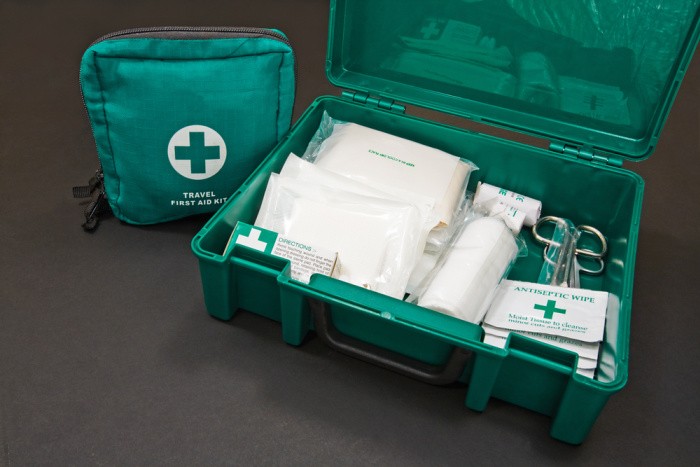

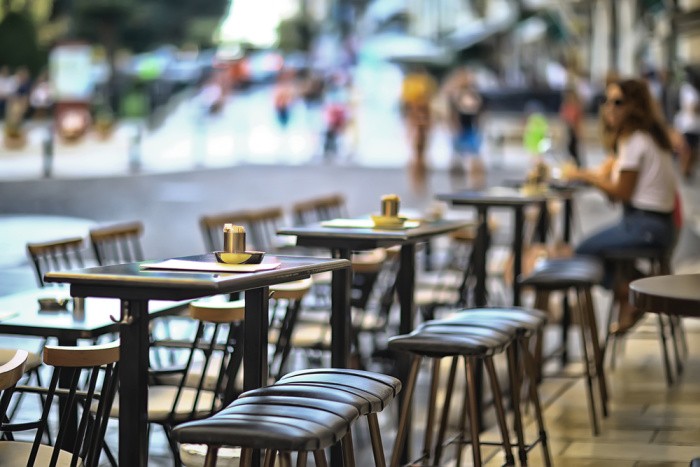
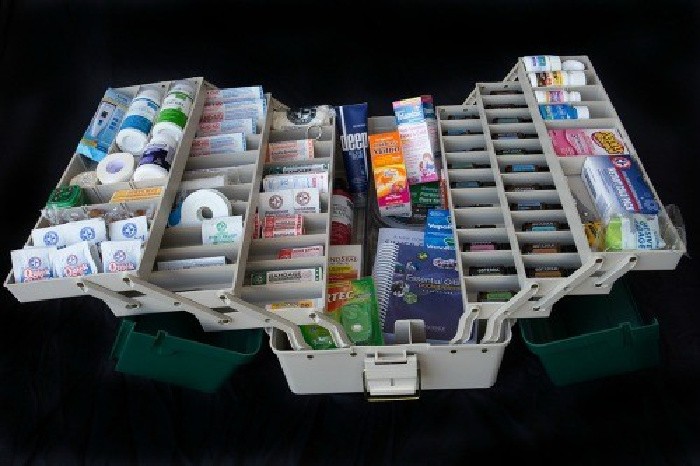
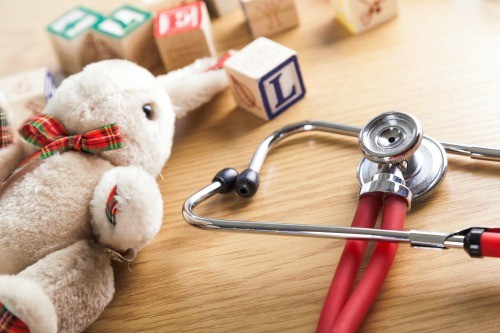
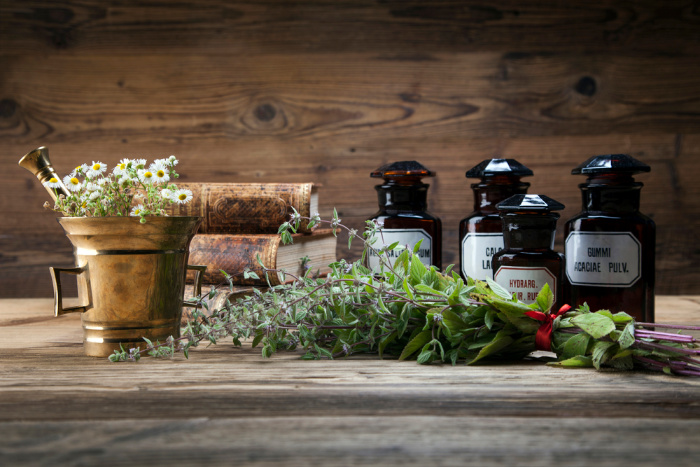
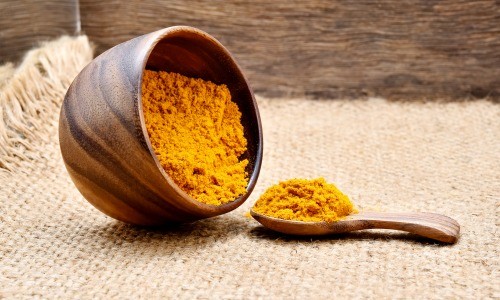
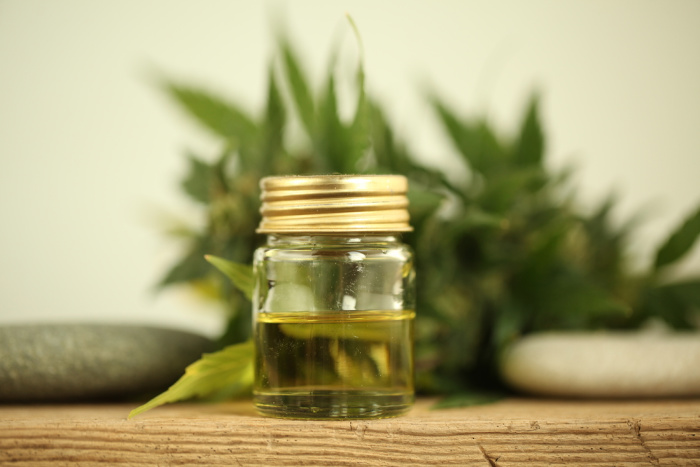
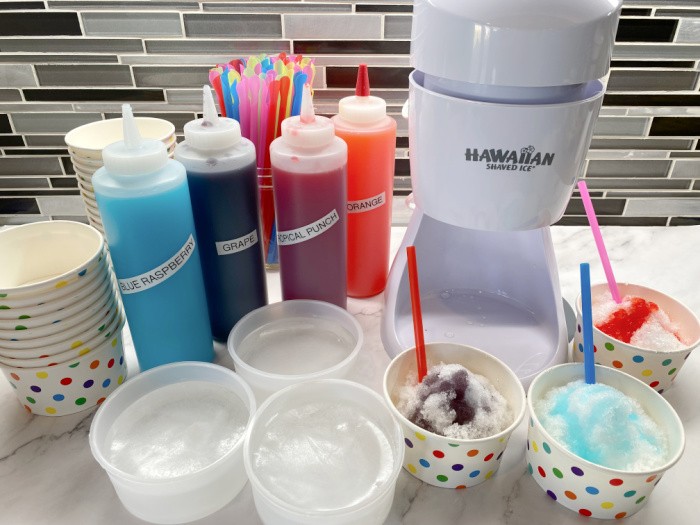

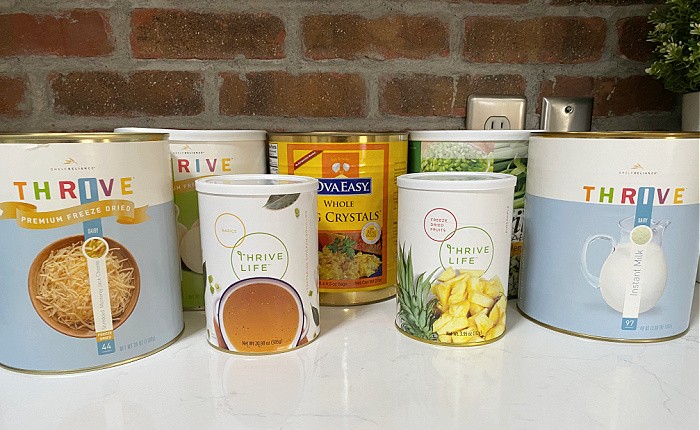
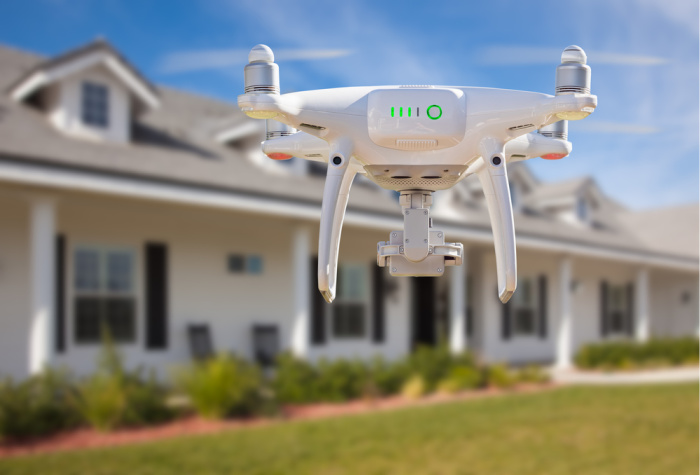
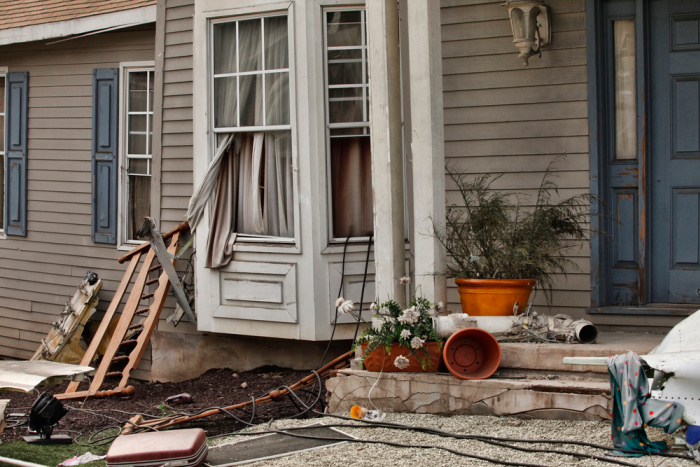
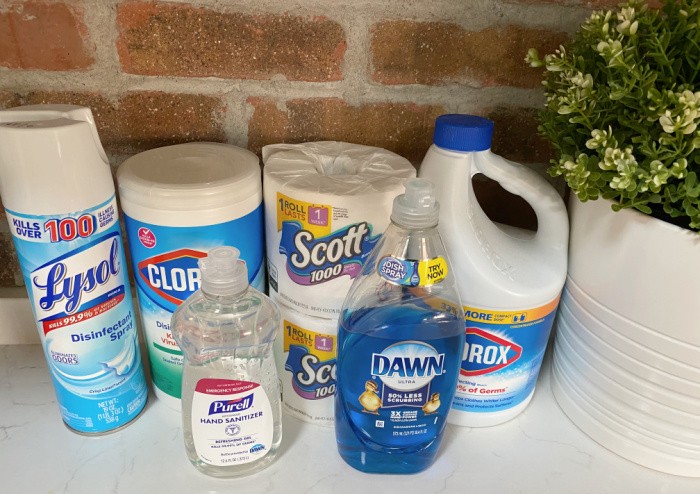
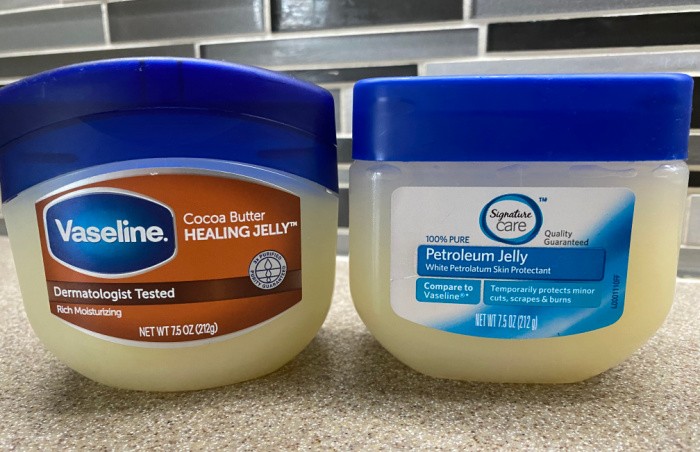
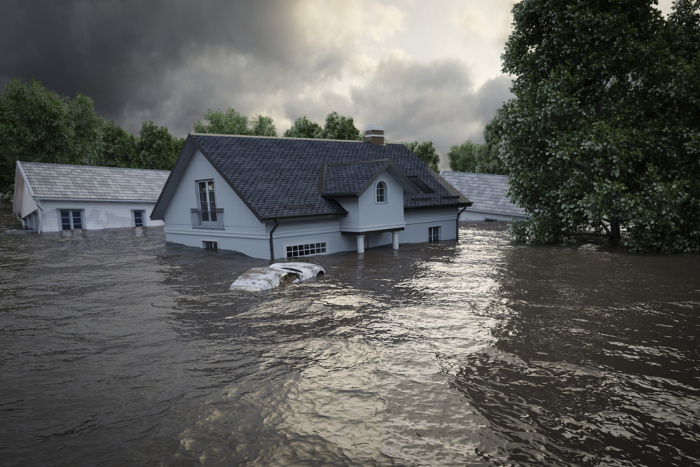
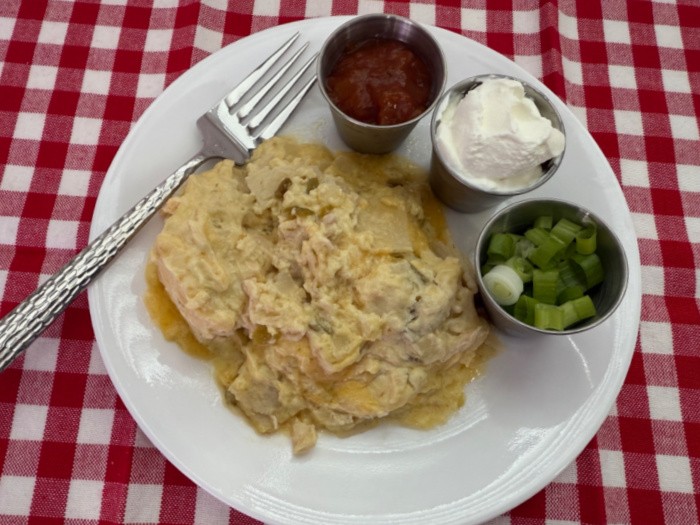
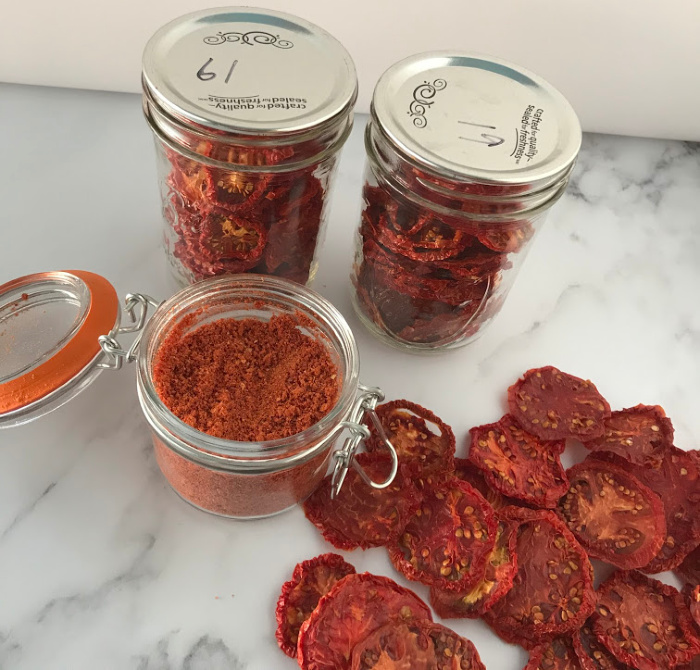
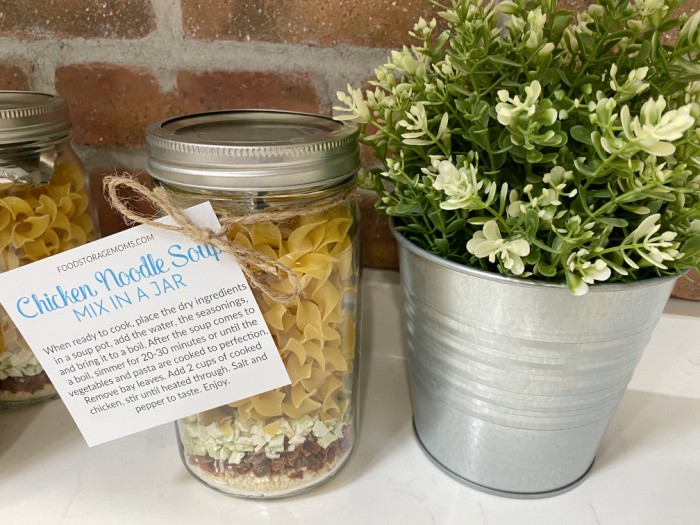
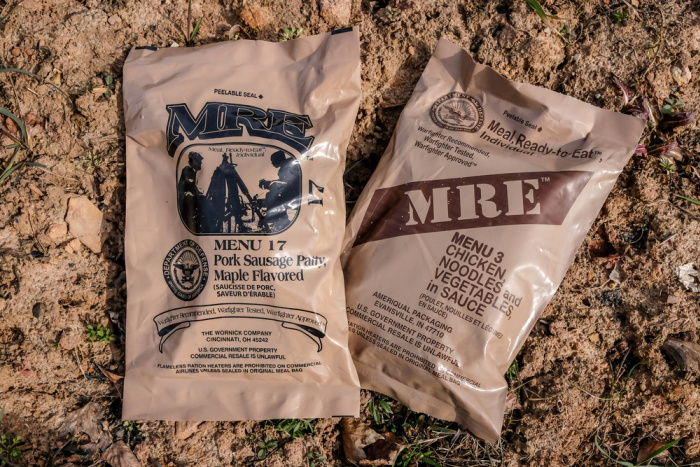

I’d add a SAM splint
https://www.sammedical.com/products/sam-soft-shell-splint?variant=18940309536857
They are bendable can be shaped and can be trimmed with those ever important shears you mentioned if say you had a broken finger and only needed a portion of it. They are lightweight and come in a variety of colors for different applications.
The colors you choose for your medical gear can be important too. Tactical is tactical but hard to see in emergencies.
Red can disappear in copious amounts of blood so it’s a poor tourniquet choice.
On the other hand if EVERYTHING is in bright colors your eyes won’t catch that piece of equipment your looking for under stress. You dump your kit and it looks like a unicorn threw up a neon rainbow then you might have defeated the purpose.
Choose wisely
Hi Matt, thank you, I have not seen this splint before, thank you! I added it to the post! Linda
FYI it’ll funnel water too if you are catching runoff into a container while camping
Hi Matt, great tip! They look awesome! Linda
I agree with Matt on the SAM Splint. I’m an ex-paramedic and wilderness first aid instructor. I’ve used SAM splints on real patients and they are great. Not only are they malleable, but they can be cut to size by good bandage scissors, if necessary.
I also agree with avoiding red colored first aid items.
Hi Christopher, great comment! Thank you so much! Linda
I might have mentioned this before and I’m sorry if I repeat myself.
I was at a meeting and there was a lady with a eye patch on, I got talking to her and she had reached in
her purse for her eye drops and didn’t pay any attention to what she grabbed and put super glue in her eye.
Of course she had to go to the doctor. She was thinking of suing Super Glue because the tube was like her eye
drops. So instead of reading her label she is going to sue. Don’t know how it turned out but just a reminder to us all.
Hi June, good grief, I hope she thought that one through before suing. That’s scary but, wow. Hopefully, her eye is okay. Thanks for sharing this story, I had not heard it before. Thank you, Linda
As usual a great list Linda. You are so helpful to us all. Thank you so much. Now I need to reassess my first aid kits.
Hi Deborah, I need those splints Matt is talking about. Linda
Morning all, hope all is going well with you. One of the things I have along with the heavy duty safety pins is diaper pins. They are a little bigger than most safety pins I’ve found and can go through multiple layers of material. I also have ace bandage clips. Don’t know if you can get them anymore due to the (sticky) sports wraps they have but I have a collection(of sorts) of Ace bandages and the little metal clips.
HI Kathy, a good reminder on the diaper pins and the ace bandage clips! Awesome! Linda
I need the splints, too. I wonder if popsicle sticks would work for fingers. I have some of those.
Hi Deborah, I bet they would! When I took the CERT class we got paint sticks from HomeDepot for splints. Linda
I have a couple of those. When I get paint again, I’ll get a few more.
HI Deborah, when we asked Home Depot they gave us a bucket of them for the class! Linda
Linda,
I have lost count of the number of times I have used superglue to seal a small cut. Works great, burns like the devil, but worth it to stop the bleeding.
Hi Harry, isn’t it wonderful that such an inexpensive item can do so much??? It does burn like the devil!! LOL! Linda
My husband and cut his hand at work. He was a train engineer, in the middle of nowhere. Anyway, he sealed it with superglue. Otherwise, he’d probable not be here. Another living proof it does work.
Hi Deborah, oh my gosh, in the middle of nowhere! YIKES! Luckily he had some superglue! Best comment! Linda
Linda:
You can also use white glue to stop a small bleed. I have done that with my kids when they were little. I think I will forgo hand sanitizer and put a bar of Dial in my emergency kit. You would not like to see my hands when I use hand sanitizer one them. Took me weeks to heal them up.
Hi Jackie, oh my gosh, hand sanitizer burned your hands??? I like Dial soap, good idea! I will have to try regular white glue!! Linda
Linda:
White glue is also great for getting out slivers. Just squeeze some over the sliver and wait a couple minutes for it to dry and out it comes no pain. As the kids say easy peasy.
Love
Jackie
Hi Jackie, easy peasy, I love it! I need to try it when I get a sliver, a great tip! Linda
I didn’t know that Dial soap was antibacterial until my surgeon told me to bathe with it before surgery. Now, I have extra bars. LOL And will stock up on more.
Hi Deborah, I didn’t know that either! Oh my gosh! Thanks for the tip! Linda
Instead of a t-shirt I have a few xl cotton dishtowels. They can be used as a sling, to bind a splint or as you stated a pressure pad for bleeding. Also being trained as an RN, a clean towel, from a ziplock bag, can be used to set up a clean field to lay tools needed for a ‘procedure’. By laying out tools needed prior to beginning you will know if something significant is missing before you are up to your elbows in the problem.
Hi Nancy, oh this is a great tip!! It’s so nice to get ideas from others, I LOVE the ziplock bag with a clean towel! Love it! Linda
A while back I cut the tip of one of my toes. The skin was hanging off. It was awful. We treated it with peroxide and antibiotic ointment. I couldn’t keep a band aid on it as while I was sleeping it came off and began bleeding again. So, we wrapped some gauze around it and covered it with duct tape. We changed it and treated it every couple of days. After a couple of weeks or so, it was healing quite well and no infection visible. Later the ‘dead skin’ peeled off and the toe is completely healed. I showed it to my sister who is an EMT and she was very impressed LOL. Said she never would have thought about using duct tape.I will have to look into that SAM splint. Thanks for some great info. May God bless and keep you safe.
Hi Judy, oh my gosh, your toe!! We can take care of ourselves, look at you!! I LOVE LOVE LOVE this comment! You rock! Linda
I just put a suture kit in my wish list for hubby to order. I did get some SAM splints in there as well. I did see a stapler and staple remover that was awesome. Amazon is my place to order. Well, one of them.
Hi Deborah, I need a stapler and stapler remover. Great minds think alike! Linda
Instead of Superglue use Vetbond. Although it is intended for pets, it is very common and many people have used it for human cuts over the past many years. Although more expensive, it is available at Amazon and many other places and doesn’t sting like superglue. After all, it is made for your pet.
Hi John, I just put the Vetbond on the post, oh my gosh, I had no idea that was available! Thank you!! I love it! Linda
For larger wounds or bullet/knife wounds keep QuikClot everywhere (in home, garage, shop, pockets, vehicles,hiking, boating, etc) This is a google link and you can buy this at WalMart, CVS, REI, Academy, BassPro, Dick’s. Please Google for QuikClot products.
Hi John, great comment, I had to take the link out because in 5 years it maybe what we call broken. Great suggestions on having QuikClot in every area. Love it, Linda
Thanks for the reply. Everyone can search for it themselves . Didn’t need the link. Thanks again.
Hi John, I always love your comments, very informative. Thank you, Linda
Hi Linda,
Hope all is well with you and yours. Question, Do you have a PRINTABLE list of these items for a first aid kit?
I need a list to refer to when I update my kit.
Thanks so much
Hi Suzanne, here is one I wrote several years ago. You can add to it. https://www.foodstoragemoms.com/wp-content/uploads/2017/08/First-Aid-Kit-For-Survival.pdf Thank you, Linda
Deborah,
Yes, popsicle sticks will work on fingers, more for children than adults. Tongue depressors are good too, more for adults. Also, buddy taping an adjacent finger to the injured finger also works, particularly if you don’t have an appropriate splint material. Always have tape in your kits, medical and duct.
Hi Christopher, thanks for the reminder on taping the adjacent fingers! I love it! Linda
Hi Linda, great post – some good ideas, but I worry about your advice with cleaning out wounds with alcohol/hand sanitiser etc. Not only does it really hurt but those substances killing the germs are also going to be killing off your exposed flesh! Then you have dead flesh in a wound that takes longer to heal and is at more risk of infection. Generally the advice I have learnt from first aid courses and family in healthcare is to wash wounds with clean running water (E.g. squirted from a bottle) and save the strong cleaners for the unbroken skin around the wound. There are exceptions for really messy cuts/grazes and bad contaminants but generally it does more harm than good.
Hi Ali, you are right, I always wash wounds with RO water at home. Thank goodness we don’t have too many!! I just fixed the post! Linda
You might want to add some dental emergency items to the list. I bought a kit on Amazon for loose crowns and lost fillings and then added a bottle of clove oil and some ambusol for dental pain. I also have some dental floss and these little brushes that are designed to clean between teeth.
Another item would be a bottle of honey, it has some healing and antibiotic properties that are good for wounds.
I also hit the clearnance sales for back to school supplies and added a couple strong 6″ and 12″ rulers to my emergency kit.
Great idea from someone about the dish towels, I’m going to add a couple of flour sack towels in a ziplock bag to my emergency kit.f I need to check into the SAM spllints and will add a solar charger to my Christmas list (I never know what to tell my hubby to give me, so that will make him happy.)
We are planning to do some off the grid camping starting next summer and I have put together an emergency kit with first aid items and other necessities. I saw a kit for treating heat exhaustion and heat stroke and thought the price was too high and put together something similar for us (and a kit for my daughter and her family) for a lower cost. I have a couple cans of emergency water, some powdered electroelyte, several of the instant cold packets, one of the cooling neck cloths that cools when wet and some old towels that can be wet and put over the person to help cool them. I had a friend who was experienced in desert hiking and knew the heat of hiking in California and yet he died from heat stroke. Which makes me paranoid and that causes me to make sure we are all well prepared.
I have a 22″ duffle bag to store my emergency kit. The heat kit is in a zippered compartment at the end of the duffle; the other end has things for cold weather. I was looking for durable and easy to use bags to set up “kits” for certain things that we would be likely to deal with when camping or in the wilderness. Interestingly enough, zippered pencil bags with a clear front ended up being the perfect solution. I have one kit for treating blisters with moleskin, sissors, bandaids, antibiotic ointment, cleansing antibacterial wipes, gauze and adhesive tape. In a small zippered front pocket of the duffle, I have items for tick and bug bites. Other kits are a light kit with 3 light sources, one that you can crank, one solar rechargable and one regular batter flashlight. I think I have about a dozen different kits, some emergency and some first aid. We must have used this 4 or 5 times while we were camping in North Dakota earlier this month, the first one being the dental kit when hubby forgot his toothbrush.
Hi Topaz, wow, I LOVE LOVE LOVE your comment. Isn’t it wonderful how all of us bring tips to this forum to help all of us? I like your idea of one end of the duffle bag is for cold and the other for heat. Heat exhaustion or heat stroke are so dangerous. I live in the desert right now, so the news reports several deaths from both each year because of the heat. I love honey for healing, a great reminder. I have a dental kit, I should add that as well. Thanks again, Linda
It never ceases to amaze me what I learn on this site plus reading all the comments. I’m pretty well stocked with what was mentioned here but can definitely add a few items. I’m going to get my flour sack towels into zip lock bags and go shop the vet section at the feed store. Having grown up on a ranch, I’ve had some pretty interesting accidents/wounds. One definitely has to be creative!
We always make it a point to go to the Emergency Preparedness Fairs put on by our Stake. My husband and I have several certifications (alas, expired but we still have the knowledge) and I ran across a field medic who had a booth on wound care. It’s amazing what one can find on Amazon. I now have Israeli Emergency Pressure Bandages in my kit, along with several other “professional” big-time supplies. Lord love a duck, I hope I never have to use them but if I do, I’ve got ’em!
Dental issues are my biggest scare. I’m the biggest baby when it comes to any kind of dental work other than cleanings. That’s definitely an area to work on. I’m so thankful for what was listed here! That’s also next on my list!
Hi Robbie, isn’t it wonderful how we can all help each other?? I love our group, I spend hours reading, researching and I still learn stuff from our forum here. Dental issues are a big issue for everyone, I believe. One thing my dentist taught me was to always have some sugar-free gum to pack on a sore tooth until you can see a dentist. We can do this, Linda
Oh, one other thing…Coban for humans is expensive. The same stuff is available at feed and ranch stores for alot less money. Alot can be found there at much cheaper prices.
My husband once shot 2 fingers together with a nail gun (ouch!) but luckily it was through the gloves and just the fleshy part of his fingers, no bones. After pulling the nail out and a very thorough cleaning, bandaging, the Coban worked well without splinting. He sure had sore fingers for awhile!
HI Robbie, oh I need to look for the Coban at the feed and ranch stores! Great tip! Oh, the nail gun, yeah my husband had someone hit his finger, not good! Linda
Love reading the post and comments.
My mother packed apples for years before she retired in the late 60s. She had paper cuts like crazy. She always kept a bottle of clear nail polish on her packing cart. If she got a paper cut, she washed it well, let it dry, then painted nail polish over the cut. I think it was mainly to keep dust and dirt out of the cut but it worked. Stings like crazy but that might be an option for really minor cuts.
Also, I had to have blood drawn at a doctor’s office a few weeks back. The nurse used that stretchy stuff to hold the gauze pad on but there was quite a bit left on the roll. I asked her what she was going to do with the rest of the roll and she said it would be tossed in the garbage. So, I brought it home!! I have some small ziplock type snack bags that I immediately put it in for my first aid kit. Don’t forget to ask for those left overs that are a part of your medical bill!!
Someone mentioned dental floss – every time I go to the dentist (2X a year) I get a small floss, toothpaste and brush. I have a few of the small flosses in my first aid kit.
I would also suggest one keep a few essential oils in their first aid kits. I keep tea tree oil (it must be diluted with a carrier oil such as fractionated coconut oil or similar), lavender, and a few others that I cannot think of off the top of my head.
I have my first aid kit in a tool box that I painted white. I then put a red cross on it out of red duct tape. It works well for me and is very visible.
I also suggest keeping a first aid book in the kit. If there is a significant accident, we can sometimes forget the very basics that we need on the spot. I also added a printed copy of uses for the essential oils I have in mine.
I didn’t see if there was advice to check your kit(s) for expired items such as asprin, ibuprofen, etc. But it is a good idea to check and replace items once or twice a year. I have my calendar set for time changes.
Oh and for the towels in ziplock bags – I just purchased some lightweight kitchen towels at Ikea. They are fairly large and I plan to cut them in half, hemming the cut side. These would be ideal for first aid kits – I’ll keep a couple in the original size and a few in the half sizes. Great idea.
Hi Leanne, oh I love the nail polish story! Ikea has some good buy, I love the idea of cutting the towels in half and putting them in bags. I love the idea of a white first aid kit with the Red Cross symbol, why didn’t I think of that! I love that idea! Linda
Some years back I found finger splints at Dollar Tree and I bought a couple. My daughter ended up using both of them so I was looking for them at Walmart. They were $6 each at the time and I had paid $1 each at Dollar Tree. Same with a tooth repair kit. $1 at Dollar Tree and $6 at Walmart. I find less and less first aid stuff at Dollar Tree, but I was happy to get what I did for $1.
HI Beth, oh Dollar Tree has some good buys. Most are a bit more than a dollar now but none the less, they have some great buys. Getting the tooth repair kit for $1.00 was a bargain. Love this! Linda
I’ve saved crutches from two bouts. 1 set of metal and one pair of woodies, against need also the walker from after Covid rehab. A plastic cast boot from a broken ankle,(also useful for sprains or injuries) reused many times, and 2 canes. Knee immobilizers are also helpful. Forearm and elbow immobilizers as well. I’ve got a sling, (a large scarf or triangular bandage will work as well) splints can be cut from heavy cardboard boxes or layers of them, boards can be used to immobilize thigh and hip fractures, with bandannas, A valuable dressing to have on hand is an ABD dressing. It a very thick bandage about 10” square. It is used to control or absorb heavy bleeding. They can be layered if need be. Metal padded finger splints or tongue depressors in case of broken fingers. They are more comfortable than taping fingers together and allow the hand a little more function. Durable medical equipment is very expensive and the first thing to run out at ER’s during emergencies, and disasters, so it’s best to save what you happen to get. Wrap well to prevent moisture and store wherever makes sense to you. Up for flooding, basement or shelter for tornadoes. A great many injuries happen before, while preparing, or after during cleanup, as well as during, and you might be on your own for extended periods. I’ve had a number of basic & advanced first aid, CPR, plus an EMT course. In addition to my Nurse’s Training, all have served my well. Add an AED to your supplies, to round out your advanced kit.
My MaryAnn, it’s interesting you mentioned an AED Defibrillator, I’ve been thinking about getting trained to use one or at least my husband. You ar so wise to save your leftover medical items. I do too! I lent my walker out and the family damaged it. They brought it back and I donated it. I figured maybe someone could fix it. I bought a new one. I need to look into that ABD dressing, I love learning about new items. You have taken a lot of classes, my friend, you rock! I totally agree save what you get after a mishap!! Linda
Linda, et al.: There are also other options for Arnica creams if you are interested: We and friends swear by Dr. King’s Acute Pain Relief (Arnica) Cream, which is amazing for bad bumps and bruises. You can buy this on Vitacost.com at the moment. I have sworn by this product ever since I met the top formulator for Dr. King’s (Bio) company. He says all other arnica products on the market have low levels of arnica in them, (I believe he said 3% or so) but are O.K. HOWEVER, when you need something more powerful, this is the only Arnica Cream that contains 15% arnica in it! Yes, Arnica is our go-to item for many injuries. The arnica gel that was used on the arm with surgery certainly would have helped, but did you know you can also buy Arnica homeopathic tablets and just put them under your tongue to melt? Amazon sells the Hyland’s Arnica tablets in a 3-pack of 50 tabs. each for a very reasonable price! We ALWAYS keep this product on hand and have for probably 15+ years! In Europe they use Arnica in the hospitals for post-surgery wounds. There are plenty of essential oils that heal wounds and even sterilize them well, like Young Living’s Onycha, which is Benzoin, actually. It disinfects wounds and causes the flesh to heal pretty quickly…used frequently during previous world wars for soldier’s wounds and saved many a limb. The only thing is to keep an eye on the wound to make sure the skin doesn’t start to heal over top of raw flesh without letting the skin heal from the bottom of the wound to the outer layer. Otherwise, Onycha is the go-to YLEO we would use for open wounds. My husband is a huge fan of Melrose blend, as well, because the Tea Tree Oil in it is very antiseptic and the Rosemary Oil with cell regenerative…so the skin should heal pretty fast.
HI Jess, I love hearing about the tablets, that is new to me. There are so many natural items we can use and I love essential oils, I need to restock mine. Great tips as always, thank you, my friend, Linda
SORRY! TYPOS AGAIN! “Rosemary Oil with cell regenerative properties” is what I was trying to say. An excellent oil, even for treating oozing infected cysts. We also always keep Melrose on hand at our home!
Joyce E. Stotts
Certified Natural Health Professional since 2006
Hi Jess, Melrose, now I need to look that one up, thank you! Linda
Just a heads up Ladies and gentlemen. My husband just started a new medication. With winter heading our way, I was concerned about not being able to build up his supply. A call to our insurance confirmed that we are eligible for a once a year vacation override, allowing us to get an extra 30 day supply. This way, I don’t have to panic incase the winter gods send us more than our fair share of snow.
Hi Chris, oh my gosh, this is a blessing to get an extra 30 day supply of a needed medication! Thank you for the tip on that! Yay! I love this, Linda
Wow, so many good ideas here… I’ll add a couple more. Yarrow has been used since at least Greek legendary times as a styptic, enough that it was also known as soldiers wort. A jar of the powder (the dried, powdered leaves) will last for several years. I haven’t used it for anything but small cuts, but I *think* it helped! It creates a pretty tough scab that protects the wound.
Veterinary shelves at the local feed store, or a vet catalogue, can provide useful items. Vet-Rap is one brand (now sort of generic, like Kleenex!) of stretchy, stick-to-itself bandage, somewhat waterproof as well.
I’d hate to tell you how many times my husband’s visiting nurse has said to go buy something-or-other, and I’ve said, “Oh, I’ve got lots out in the barn, wait a minute…”
I’d also suggest keeping some basic homeopathic treatments on hand. They won’t go bad, and you really can’t do any harm with them. Arnica for bruises is the one we all know, but read up for others. (I had a horse with violent insect allergies–was able to get him off steroids just using Ledum Pal.!)
H Rhonda, great idea on. getting used to using homeopathic treatments! Learn to use them, study and research for those you could use. I’m going to Goolge Ledum Pal, I love learning new things, you’re the best! Great ideas! Linda